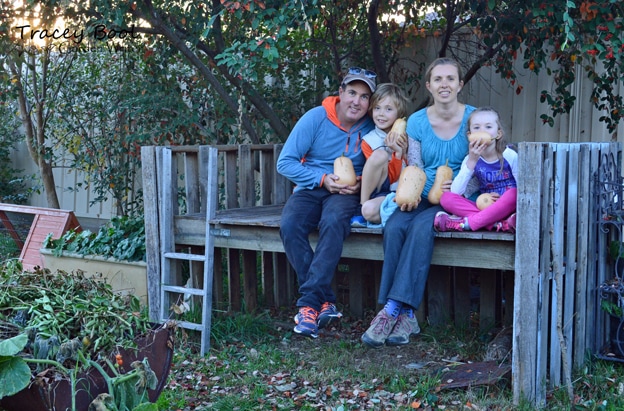|
Plants, Bees, Veggies and a Preserving Wonderland (June 2016) When out and about recently, I met the Bates family – Katy, Greg, Nathan and Ruth – a dynamo team, growing plants on their rental property for eating, creating wildlife and beneficial insect habitats, and fun. Katy, Permablitz ACT Coordinator, has a strong productive garden history as a 4th generation organic gardener. Katy and Greg also run the local Primary School Garden Club. Last year, the family came across volunteer organisation 100kilos.org at an ANU Food Co-op Swap meet, prompting their curiosity to record their productive harvest and strive for a more thoughtful and supermarket free way of living. And so this story begins. The front yard is home to a native garden, a reed bed, and a Bee flower garden, all designed to encourage and support native wildlife and beneficial insect populations. There are 3 large veggie beds, built on contour to absorb the maximum amount of natural rainfall. The beds housed stellar crops over summer, including a white zucchini plant spanning 6m and producing an enviable harvest. And to provide additional water during dry weather, there is an upcycled IBC (International Bulk Container) connected to the house guttering. The back yard has 7 wicking beds (self-watering pots) - 6 are IBC’s cut in half, and one is an upcycled bath tub. Each IBC bed is 500ltrs in volume. Amongst the obvious benefits of using wicking beds to grow plants, the family utilises them to exclude the menace Couch grass in residence. The sizeable raspberry patch keeps the family in supply of these delectable morsels for an enviable and extended harvesting season – during peak harvest, the Bates were picking 300g daily. Lots of weird, wonderful, and yummy plants are grown throughout, such as yellow guava, finger lime, yacon, water chestnuts, wasabi, Gooseberries, saffron, and chick peas. A yumbo and equally as aesthetic bean variety called ‘Rattlesnake’ was still producing at the time, having since been added to my ever-increasing ‘to grow’ veggies list. There are 4 natural ‘top bar’ style beehives on site (aka Kenyan top bar hives), which Greg constructed using mostly recycled timber. Top bar hives were designed specifically to: make use of upcycled products in countries with limited resources; to be sturdy enough to erect in trees and the like; and to withstand the attentions of curious and often sizeable wildlife. This growing season, the Bates family has harvested a staggering 303.825kg of produce, from around 65 varieties of plants! To give you an idea of the value of this volume, the family estimates 300kg of like produce at Coles to be $2300. The harvest store and preserving room is sizeable and impressive – jams, pickles, sauces, fruit meads, cider and ginger beer adorn many a shelf, cupboard and cold storage facility. There is also a large seed collection from the couple’s supplier of choice, Diggers, as well as those collected from the garden. The family have since moved to a farm stay near Yass, and I don’t know about you, but I keenly await to hear about their future home-growing endeavours. You can learn more about the family’s vegetative adventures via Bates Homestead Community page on Facebook. Also check out: www.permablitzact.com www.100kilos.org foodco-opshop.com.au/ |


